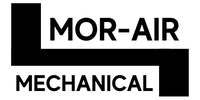Understanding Air Conditioning Ductwork for Commercial Spaces
A breakdown of the key components, layout considerations, and why ductwork matters in HVAC systems.
According to SEAI, inefficient ventilation and air distribution systems can contribute to 20–30% higher energy use in commercial buildings.
What Is Air Conditioning Ductwork and Why Does It Matter?
Ductwork is the network of tubing used to circulate cooled or heated air throughout a building. In commercial HVAC systems, the quality and layout of the air conditioning ductwork plays a critical role in maintaining comfort, reducing energy consumption, and ensuring even airflow.
Poor duct design can lead to hotspots, pressure imbalances, and noise issues. Common materials include galvanised steel, aluminium, and insulated flexible ducts — each with specific use cases depending on airflow needs and space constraints.
For tailored setups across commercial, retail, or industrial environments, explore Mor-Air’s duct and ventilation materials designed for performance and compliance.
Designing Efficient Ductwork for Commercial Buildings
Ductwork must be designed to match the capacity and zoning of the AC unit. This includes properly sized trunks and branches, sealed joints, and accessible vents for future maintenance. Duct shape, bends, and length all influence air velocity and efficiency.
In commercial buildings with open spaces, ceiling-mounted diffusers are common, while suspended or concealed systems suit fit-outs. Acoustic insulation can also reduce noise transfer between rooms. Poor airflow planning can create cold spots and lead to wasted energy.
Check out our ventilation installation services to ensure your ducting is set up for long-term performance and compliance.
Maintaining Ductwork for Efficiency and Compliance
Ongoing duct maintenance prevents buildup of dust, mould, or even pests. It also ensures optimal system pressure and airflow. This is especially important in environments like restaurants, healthcare, or office buildings, where clean airflow directly affects comfort and safety.
Inspections should be carried out regularly, especially before peak seasons. Dirty or blocked ducts force AC systems to work harder, driving up electricity costs. Sealing leaks, cleaning filters, and checking insulation go a long way in preserving your investment.
For more insights into energy-smart HVAC strategies, read our blog on heat recovery ventilation in Ireland.
Need Assistance? Get in Touch
-
Phone Number
+353852528522 -
Email
admin@mor-air.com -
Location:
Ireland Nationwide -
Office Hours:
Mon-Sat: 7am - 5pm

